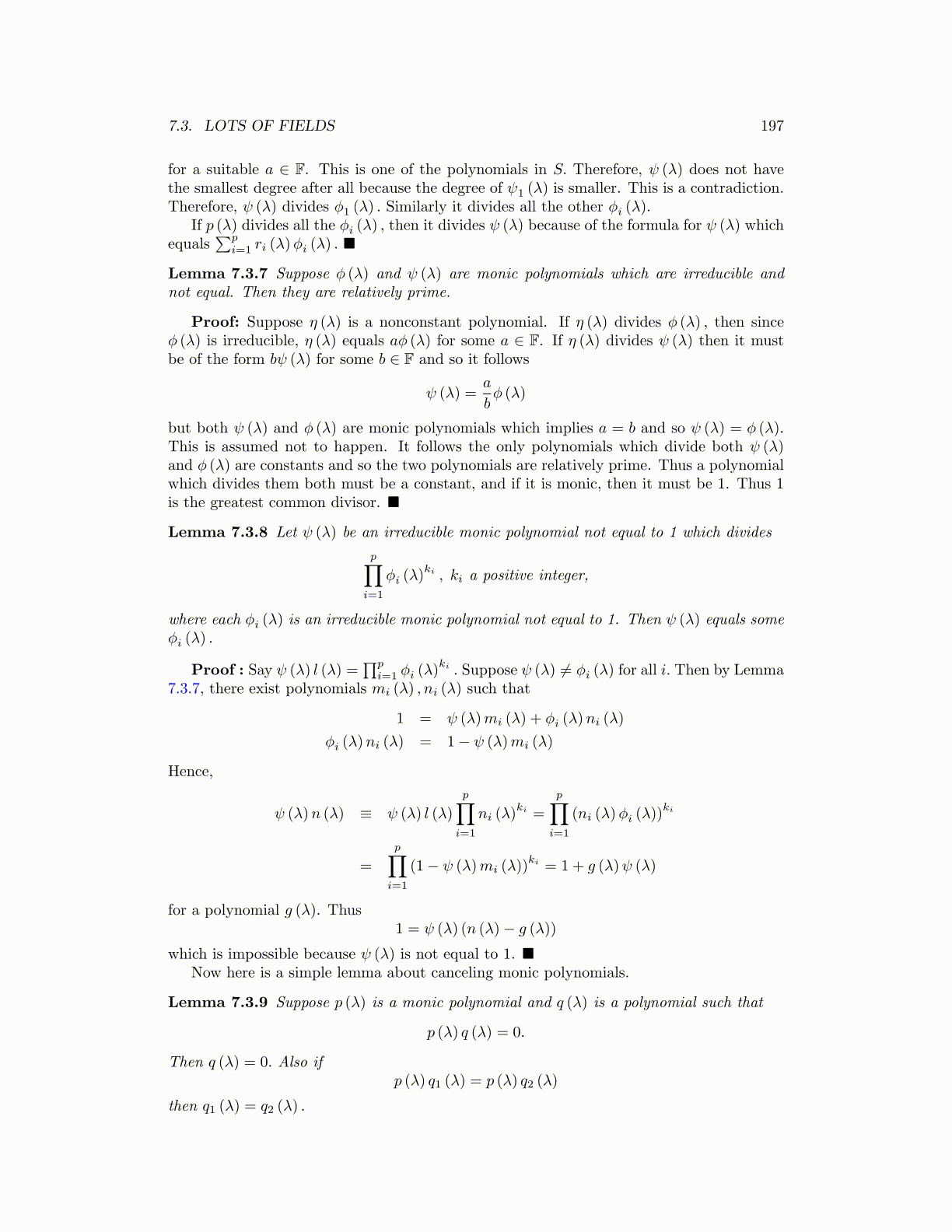
7.3. LOTS OF FIELDS 197
for a suitable a ∈ F. This is one of the polynomials in S. Therefore, ψ (λ) does not havethe smallest degree after all because the degree of ψ1 (λ) is smaller. This is a contradiction.Therefore, ψ (λ) divides ϕ1 (λ) . Similarly it divides all the other ϕi (λ).
If p (λ) divides all the ϕi (λ) , then it divides ψ (λ) because of the formula for ψ (λ) whichequals
∑pi=1 ri (λ)ϕi (λ) . ■
Lemma 7.3.7 Suppose ϕ (λ) and ψ (λ) are monic polynomials which are irreducible andnot equal. Then they are relatively prime.
Proof: Suppose η (λ) is a nonconstant polynomial. If η (λ) divides ϕ (λ) , then sinceϕ (λ) is irreducible, η (λ) equals aϕ (λ) for some a ∈ F. If η (λ) divides ψ (λ) then it mustbe of the form bψ (λ) for some b ∈ F and so it follows
ψ (λ) =a
bϕ (λ)
but both ψ (λ) and ϕ (λ) are monic polynomials which implies a = b and so ψ (λ) = ϕ (λ).This is assumed not to happen. It follows the only polynomials which divide both ψ (λ)and ϕ (λ) are constants and so the two polynomials are relatively prime. Thus a polynomialwhich divides them both must be a constant, and if it is monic, then it must be 1. Thus 1is the greatest common divisor. ■
Lemma 7.3.8 Let ψ (λ) be an irreducible monic polynomial not equal to 1 which divides
p∏i=1
ϕi (λ)ki , ki a positive integer,
where each ϕi (λ) is an irreducible monic polynomial not equal to 1. Then ψ (λ) equals someϕi (λ) .
Proof : Say ψ (λ) l (λ) =∏p
i=1 ϕi (λ)ki . Suppose ψ (λ) ̸= ϕi (λ) for all i. Then by Lemma
7.3.7, there exist polynomials mi (λ) , ni (λ) such that
1 = ψ (λ)mi (λ) + ϕi (λ)ni (λ)
ϕi (λ)ni (λ) = 1− ψ (λ)mi (λ)
Hence,
ψ (λ)n (λ) ≡ ψ (λ) l (λ)
p∏i=1
ni (λ)ki =
p∏i=1
(ni (λ)ϕi (λ))ki
=
p∏i=1
(1− ψ (λ)mi (λ))ki = 1 + g (λ)ψ (λ)
for a polynomial g (λ). Thus1 = ψ (λ) (n (λ)− g (λ))
which is impossible because ψ (λ) is not equal to 1. ■Now here is a simple lemma about canceling monic polynomials.
Lemma 7.3.9 Suppose p (λ) is a monic polynomial and q (λ) is a polynomial such that
p (λ) q (λ) = 0.
Then q (λ) = 0. Also ifp (λ) q1 (λ) = p (λ) q2 (λ)
then q1 (λ) = q2 (λ) .